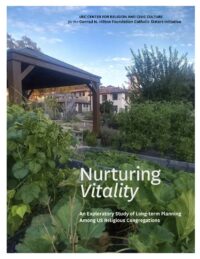Introduction
In 1912, four German Pallottine Missionary sisters missed a trans-Atlantic trip that they had scheduled on the Titanic, instead taking the next boat to the United States. With “God watching over them and their mission,” they eventually wound up in West Virginia to set up a medical clinic in an impoverished area.
Over the next decades, the Pallottine order would go on to establish hospitals in West Virginia and run schools across the Mid-Atlantic and Midwest, and grew to include hundreds of sisters. While there are still 550 sisters in the order internationally, today the US congregation has only 19 sisters. In recent years, the Pallottine Missionary Sisters have sold both of their hospitals in West Virginia and set up hospital conversion foundations that are dedicated to the health care needs of their local communities.
Many congregations of women religious in the US are on a similar path. Starting small, they grew their membership and established large institutional footprints over the course of the 20th century, and now have returned to smaller sizes. Today, sisters are going through the process of discerning how to carry their charism forward. For the Pallottine Missionary Sisters, that meant establishing “a foundation that lives on long after the sisters are gone.”
The Center for Religion and Civic Culture (CRCC) at the University of Southern California conducted an exploratory study to identify approaches that women religious and their congregations in the United States are using to address the issues of aging, retirement and vitality. This study is part of CRCC’s activities as the Measurement, Evaluation and Learning (MEL) partner for the Conrad N. Hilton Foundation’s Catholic Sisters Initiative. Research on the vitality of congregations of women religious, and how they are responding to the challenges and opportunities of aging and retirement, was identified as a concern by the Catholic Sisters Initiative team and the Conrad N. Hilton Foundation’s Board of Directors in 2018.
One of the goals of the Catholic Sisters Initiative is to support the vitality of congregations of women religious. In the global north, it has supported research to understand what vitality means to Catholic sisters and projects geared to increasing the number of women who become sisters. In light of CRCC’s findings that philanthropy is unlikely to dramatically increase the number of women joining religious congregations, the Catholic Sisters Initiative asked CRCC to conduct research about how US congregations are nurturing their vitality as they grow older and smaller. This study will help the Catholic Sisters Initiative to implement Phase II of its strategy (2018–2023).
CRCC used purposive sampling, interviewing women religious and congregations who responded affirmatively to our inquiries about the prospect of including their stories in this report. By speaking with sisters from seven congregations across the country, CRCC aimed to capture the geographic diversity of sisters, along with a representative range of challenges and strategies in response to aging. The following report includes case studies of five of the congregations. Each of the cases includes a basic overview of the congregation’s history and ministries as well as the key challenges illustrated in the case study, which are more fully detailed in the narrative.
This study is exploratory in nature and is not meant to be representative of the entire experience of and response to aging, retirement and vitality among all women religious in the United States. These cases reveal common themes and offer a portrait of the changing face of Catholicism in the United States.
CRCC found that long-term planning is enabling the congregations studied to remain vital—able to adapt to new challenges with a sense of possibility. Further, they are nurturing their vitality on three levels: within individual sisters, their institutions and partnerships. All of the congregations studied are developing internal structures that will allow their charisms to continue after them, with essential support from networks and lay people. And as is consistent with CRCC’s finding that the formation of sisters is a lifelong process, the sisters we interviewed spoke of the need for continued spiritual support as they age.
These themes are reflected in the recommendations for the Catholic Sisters Initiative’s grant-making strategy, namely that future investments could:
- Encourage a healthy, realistic attitude around health and well-being as an essential component of lifetime formation.
- Provide consultants—particularly for smaller, less resourced congregations—to advise on technical and spiritual strategies to support congregational vitality, aging and retirement.
- Expand the availability of TRENDS software and other technologies to assist congregations and their members in planning for their future.
- Engage in partnerships with organizations currently supporting congregational vitality and make their resources more widely available.
- Support networks of organizations and congregations to disseminate useful models addressing the challenges of aging and retirement.
These recommendations will be explored in more detail through the congregational case studies
in this report and in the final recommendations section that follows.
CRCC found that, in their approach to both their present ministries and the legacy they hope to leave for future generations, the congregations studied were very much vital congregations, offering direction and inspiration for other communities of women religious. It is CRCC’s hope that the issues and learnings uncovered in the five case studies will inform the Catholic Sisters Initiative as it seeks to “give aid to the sisters.”
Click here to read the full report.
